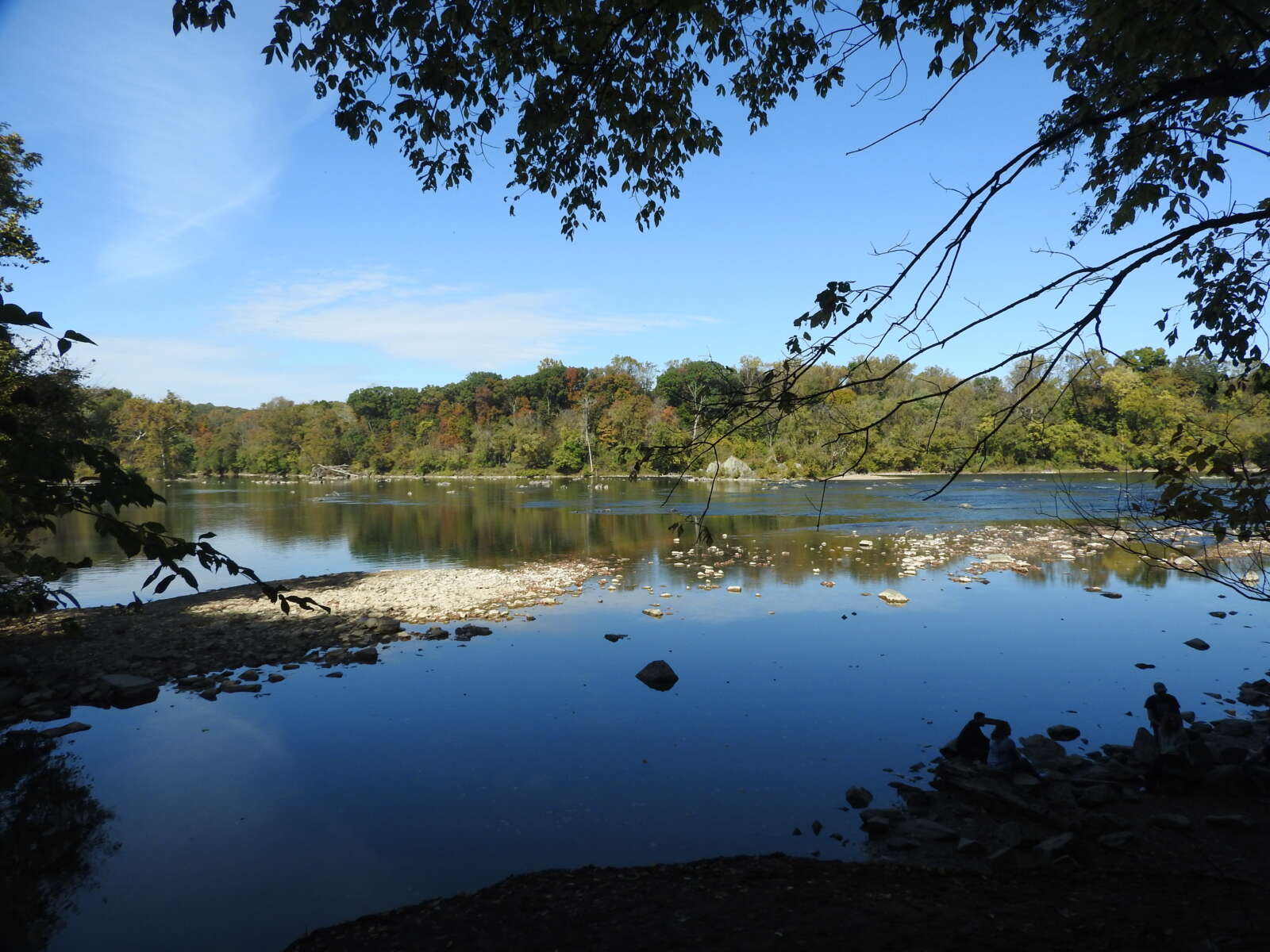
(Updated at 3:30 p.m. on 3/29/2024) Clogged-up pipes will force Scott’s Run Nature Preserve to close for more than a month, starting later this week.
Contractors will begin work on the “emergency project” to clear and repair wastewater pipes in the McLean park this Thursday (March 28), the Fairfax County Department of Public Works and Environmental Services recently announced.
The 385-acre park at 7400 Georgetown Pike will be closed throughout the project’s first phase, which is expected to take about six weeks and will remove an estimated 80 tons of sediment from the pipes, according to DPWES.
Also known as siphons, the pipes carry wastewater from McLean across the Potomac River and into Maryland, connecting to a DC Water interceptor through Carderock National Park.
“During a recent inspection two of the three pipes at the wastewater siphon were found to be non-operational,” DPWES said in a news release. “An emergency repair is necessary, as there is no reasonable bypass alternative if the last pipe fails, which would mean millions of gallons of sewage per day going into the Potomac.”
According to the project page, the park needs to close during the project so construction crews and equipment can access the trails without creating conflicts for visitors or pushing pedestrians off-trail, which would damage the natural environment.
Work will take place Monday through Saturday from 7 a.m. to 7 p.m., depending on the weather. The closure will apply to all trails and the east and west parking lots.
In addition to removing sediment, which will be transported out of Scott’s Run daily by truck, the project will involve replacing valves and cleaning the siphon barrels. The siphon barrel cleaning will be done in Carderock National Park.
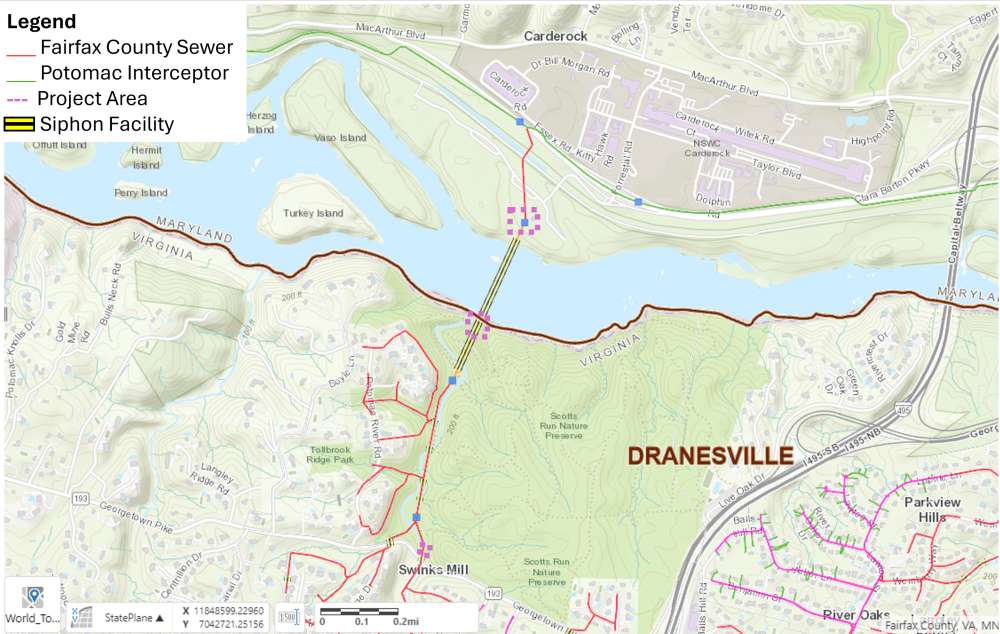
A second phase of work focused on maintenance repairs is expected later, requiring another park closure, but the exact timing will be determined after “additional investigations are made during the cleaning process,” DPWES said.
In total, the work at Scott’s Run is expected to take three months, though the overall project has an anticipated timeline of six to nine months.
DPWES says no other properties should be affected by the project, and traffic into and out of the Scott’s Run parking lot will be “limited” after the contractors arrive Thursday morning.
“Materials and construction equipment for the project will be safely stored onsite,” the project page says. “Additionally, Fairfax County McLean District Police have been notified of the project and will be monitoring traffic patterns in the area to ensure safety of residents and commuters.”
The county says it’s identifying “methods to optimize and enhance its inspection and cleaning procedures to reduce the likelihood” that an emergency response of this level will be needed in the future.
Correction: DPWES says 80 tons of sediment are being removed from the Scott’s Run pipes, not 80,000 tons as first reported.
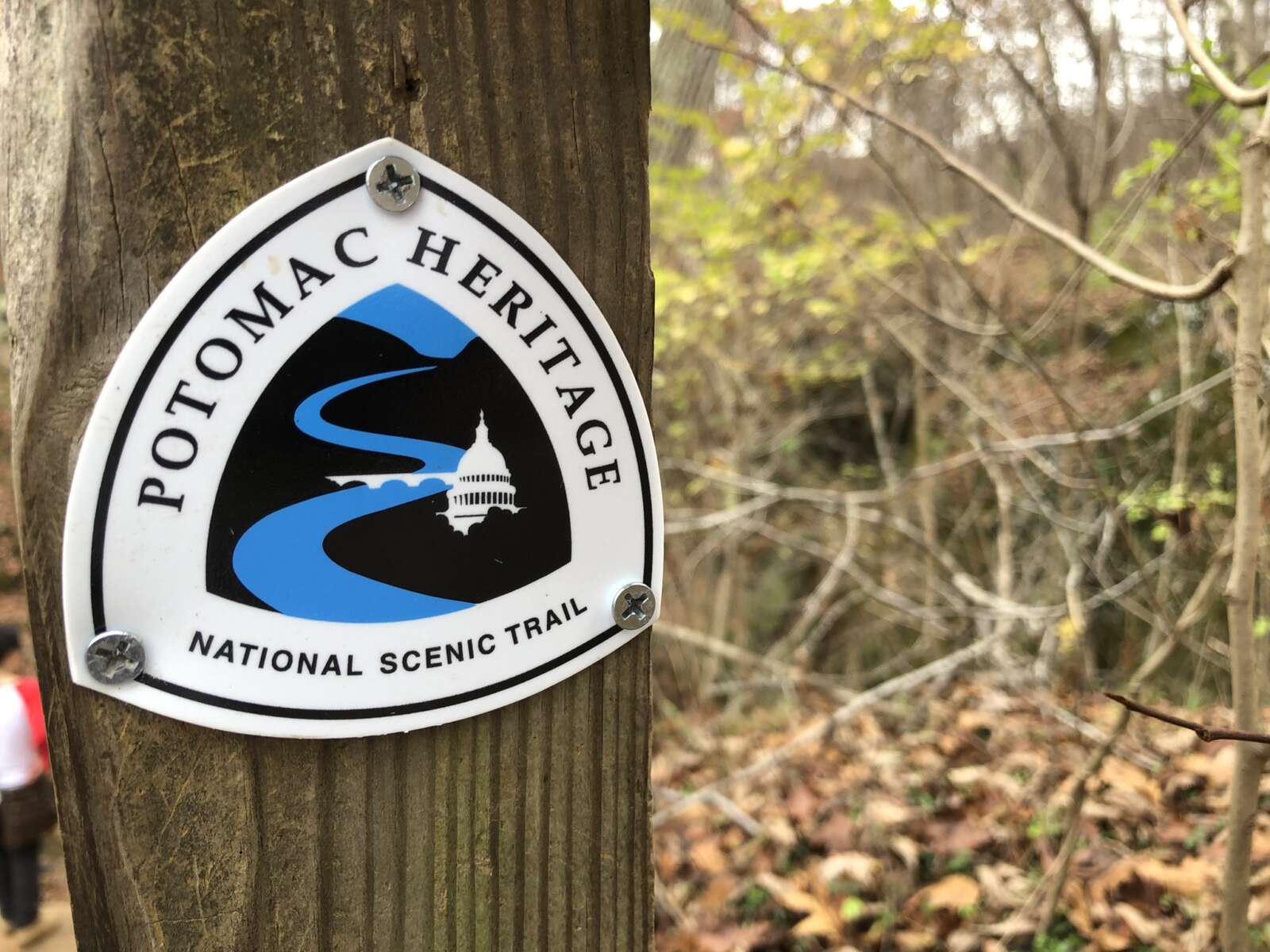
Fairfax County will add its voice to the chorus of local governments touting the presence and benefits of the Potomac Heritage National Scenic Trail.
The Board of Supervisors authorized staff on Tuesday (Oct. 10) to sign an agreement committing the county to developing, maintaining and promoting its segments of the trail, which spans almost 900 miles from the Allegeny Highlands in western Pennsylvania to the Potomac River’s mouth in Northern Neck.
The roughly 137-mile Northern Virginia section includes segments in Great Falls, McLean and along the George Washington Memorial Parkway and Route 1 (Richmond Highway) from the City of Alexandria to Lorton.
“This is a mostly unknown trail connection that we’ve all been working on, believe it or not, for years,” Mount Vernon District Supervisor Dan Storck said before the board’s unanimous vote.
Designated in 1983, the Potomac Heritage Trail is overseen by the National Park Service, but it has enlisted local governments to manage segments in their borders under the memorandum of understanding (p. 413), which was initially developed in 2020.
In addition to Fairfax County, participating localities include Arlington, Loudoun and Prince William counties, along with Alexandria and the towns of Dumfries, Leesburg and Occoquan.
Per the MOU, the county’s park authority and transportation and public works departments will maintain trail segments, place markers at key points like major trailheads, promote the trail with media and way-finding or interpretive exhibits, and report on “visitation, volunteerism, and challenges and needs for completed segments.”
“The purpose of the agreement is to recognize the Trail network in northern Virginia and to realize fully the benefits associated with such recognition, including increased opportunities for outdoor recreation and nonmotorized transportation; for education, health, and heritage tourism; and for contributions to a vibrant regional economy,” county staff wrote in a summary for the Board of Supervisors.
The MOU also directs trail managers to “consider requests to plan, acquire lands and easements for, and develop segments of the Trail within respective jurisdictions.”
Fairfax County recently filled some gaps with the Mount Vernon Highway Trail Project, which added a shared-use path from Route 1 to Southwood Drive and was completed in May.
Storck said at Tuesday’s board meeting that his office has been working over the last few months to adjust some of the new trail segments “so they’re not right on Route 1.”
Working with Fort Belvoir to move its segments off the road has proven to be a challenge due to Defense Department rules on “what you can do and where,” but Storck said there has been “great progress” made on the trail.
“We’ll need to continue [that progress],” he said. “This will be something that gets worked on long after I’m gone, to find better ways to have it be more scenic and less urban…We’re doing the right thing, and as you see, it’s taken 50 years just to get this far, so we’ll keep plugging away.”
According to a trail map maintained by the Northern Virginia Regional Commission, Fairfax County still has gaps in the Mason Neck Trail along Gunston Road, on Old Colchester Road to connect Route 1 to the Mason Neck Peninsula, and between Great Falls Park and Scott’s Run Nature Preserve.
The Great Falls-to-Scott’s Run segment is unfunded, though one needed easement has been obtained at the Madeira School in McLean. The Gunston Road segment will cost an estimated $9 million and has gotten $4 million funded so far.
The route connecting Route 1 and Mason Neck may be tweaked as the county updates its overall trails map as part of its ActiveFairfax Transportation Plan, which is “tentatively” expected to get adopted in 2024, according to NVRC.
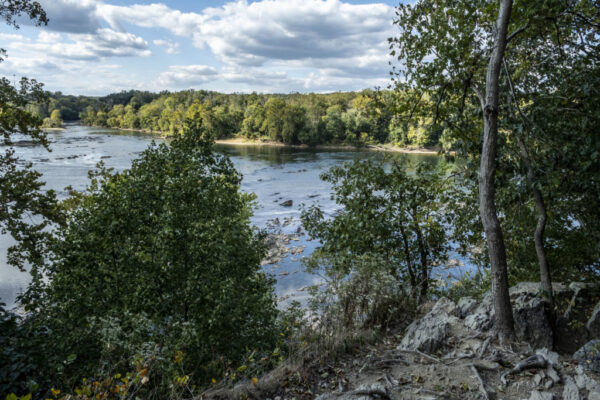
The ongoing widening of I-495 from Tysons to McLean will require the permanent taking of 1.15 acres from Scott’s Run Nature Preserve.
As compensation, the Virginia Department of Transportation has proposed building a new park for the Fairfax County Park Authority on a 1.83-acre site at the corner of Georgetown Pike and Balls Hill Road that it currently uses as a maintenance yard.
“This is a commitment that we made and worked very closely with the park authority to provide all the features that they require,” VDOT Megaprojects Director Susan Shaw told the Board of Supervisors’ transportation committee last Friday (Sept. 30).
According to a draft agreement dated July 12, VDOT will dedicate a 1.27-acre portion of its property to a park with seating, bicycle racks and a repair station, “passive open space,” and a plaza at the head of a 10-foot-wide connection to a trail along Georgetown Pike.
The trail is part of a regional network that VDOT has committed to providing as part of the I-495 Northern Extension (495 NEXT) project, which is extending the interstate’s toll lanes about three miles from the Dulles Toll Road toward the American Legion Bridge.
“The expanded trail network will likely exacerbate the currently stressed parking situation at the [Scott’s Run] Preserve, a very popular park in Park Authority’s system that became overwhelmingly popular during the COVID-19 pandemic,” the agreement shared with FFXnow says.
To support that increased demand, VDOT’s proposed park will have a circular parking lot with 25 spaces, four of them designed as ADA-accessible. The department will also construct a 5-foot-wide sidewalk along Balls Hill Road, leading into the park.

VDOT needs to obtain “a right of entry” by Nov. 15, but the park authority has been “very helpful in working together with us,” Shaw said.
“There are still some final steps. It’s very tight, but we feel like we’re on track to meet that Nov. 15 date,” she said. Read More
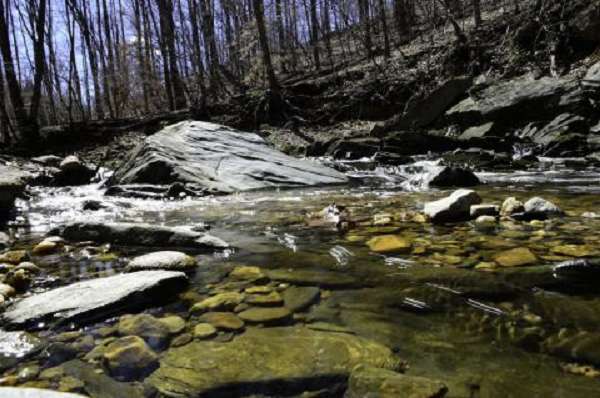
With summer on the horizon, visitors are expected to flock to Scott’s Run Nature Preserve in McLean, but the Fairfax County Park Authority is warning now: leave the coolers, alcohol, and swimming suits at home.
The park authority and Fairfax County Police Department will step up enforcement of the nature preserve’s rules starting this weekend (May 28-29), a move that has become routine in recent summers.
“The Fairfax County Park Authority will be working collaboratively with the Fairfax County Police Department to ensure only permitted activities take place in this natural area, that people can recreate safely, and that the rules as they apply to alcohol and use of the preserve are observed,” the FCPA said in an announcement on Wednesday (May 25).
Visitors might be ejected from the park and prohibited from returning in the future if they violate the following policies:
No coolers are allowed. No alcohol or glass bottles are permitted in Scott’s Run. Bags will be checked at parking lot trailheads. Enforcement will be stepped up at the waterfall area. The beauty of the falls masks its peril. This area is subject to dangerous currents, and submerged rocks can combine with those currents to make entering the water a deadly decision. Rain upstream can raise water levels astonishingly quickly.
No swimming, wading or boating allowed at Scott’s Run. Crowds in the water threaten the many invertebrates and the remarkable and rare plant species that call the preserve home. Parking is limited to 50 cars in the designated parking areas. No parking is permitted in adjacent neighborhoods or along the roadway leading to the park. Dogs must be on a leash while in the park.
Located at 7400 Georgetown Pike, Scott’s Run Nature Preserve encompasses 385 acres between Georgetown Pike and the Potomac River.
With its scenery and relative seclusion from traffic and other signs of development, the park draws approximately 600 visitors per day annually, but those numbers climb to about 1,000 people a day during the peak season, which is typically summer until early fall, according to FCPA spokesperson Judith Pedersen.
Scott’s Run — the river that bisects the park and feeds into the Potomac — gives the park “one of the rarest biological ecosystems in the mid-Atlantic,” the FCPA said in a 2017 blog post.
The park authority said a perception persists of the preserve as a “safe swimming hole,” despite people getting trapped in the past by high waters and the dangers swimming poses to the environment. The agency also bans alcohol and glass bottles to discourage revelers and littering.
“The park draws people because it is remote and beautiful, but some visitors take advantage of that to drink alcohol illegally and to leave the site trashed,” the FCPA said in the blog post. “Trash is a blight that ruins the next visitor’s park experience and that eventually floats downstream in the Potomac River into the Chesapeake Bay, causing pollution and impacting wildlife.”

